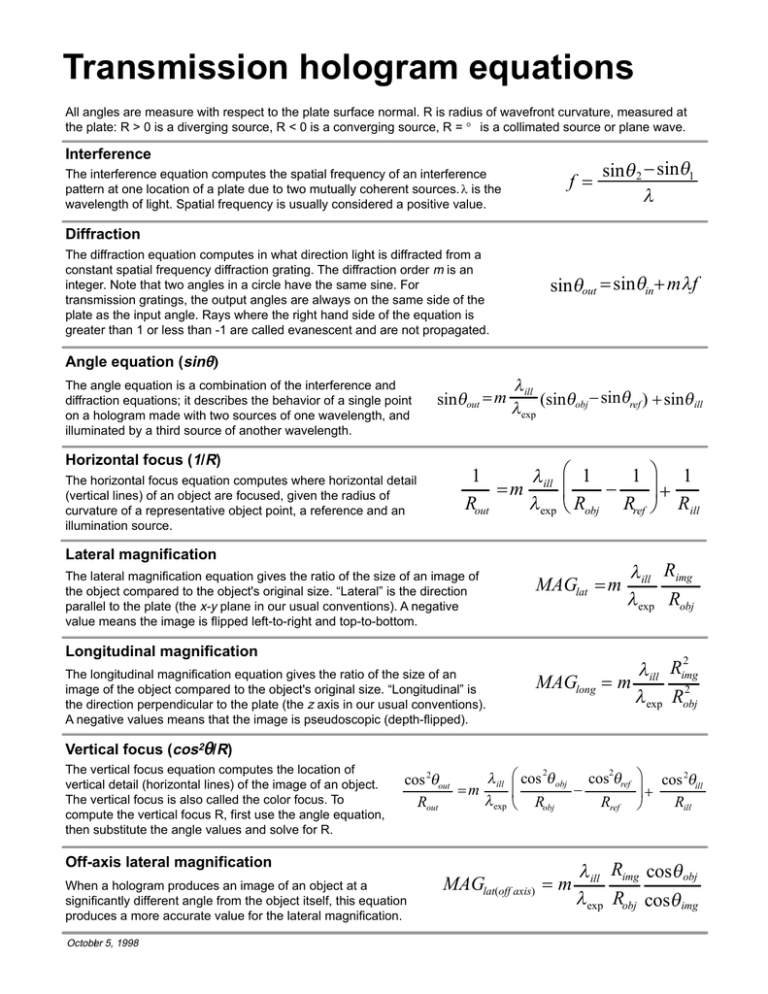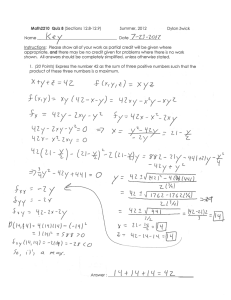Transmission hologram equations
advertisement

Transmission hologram equations All angles are measure with respect to the plate surface normal. R is radius of wavefront curvature, measured at the plate: R > 0 is a diverging source, R < 0 is a converging source, R = ∞ is a collimated source or plane wave. Interference f= The interference equation computes the spatial frequency of an interference pattern at one location of a plate due to two mutually coherent sources. λ is the wavelength of light. Spatial frequency is usually considered a positive value. sinθ 2 − sinθ1 λ Diffraction The diffraction equation computes in what direction light is diffracted from a constant spatial frequency diffraction grating. The diffraction order m is an integer. Note that two angles in a circle have the same sine. For transmission gratings, the output angles are always on the same side of the plate as the input angle. Rays where the right hand side of the equation is greater than 1 or less than -1 are called evanescent and are not propagated. sinθout = sinθin+ mλf Angle equation (sinθ θ) The angle equation is a combination of the interference and diffraction equations; it describes the behavior of a single point on a hologram made with two sources of one wavelength, and illuminated by a third source of another wavelength. Horizontal focus (1/R) The horizontal focus equation computes where horizontal detail (vertical lines) of an object are focused, given the radius of curvature of a representative object point, a reference and an illumination source. sinθout = m λ ill (sinθobj − sinθref ) + sinθ ill λexp 1 λ = m ill Rout λ exp 1 1 1 − + R obj Rref Rill Lateral magnification The lateral magnification equation gives the ratio of the size of an image of the object compared to the object's original size. “Lateral” is the direction parallel to the plate (the x-y plane in our usual conventions). A negative value means the image is flipped left-to-right and top-to-bottom. Longitudinal magnification The longitudinal magnification equation gives the ratio of the size of an image of the object compared to the object's original size. “Longitudinal” is the direction perpendicular to the plate (the z axis in our usual conventions). A negative values means that the image is pseudoscopic (depth-flipped). MAGlat = m λ ill Rimg λ exp Robj 2 λ ill Rimg MAGlong = m 2 λ exp Robj Vertical focus (cos2θ/R) The vertical focus equation computes the location of vertical detail (horizontal lines) of the image of an object. The vertical focus is also called the color focus. To compute the vertical focus R, first use the angle equation, then substitute the angle values and solve for R. λ ill cos 2θout =m λ exp Rout cos 2θ obj cos2θref cos 2θ ill − + R R R obj ref ill Off-axis lateral magnification When a hologram produces an image of an object at a significantly different angle from the object itself, this equation produces a more accurate value for the lateral magnification. October 5, 1998 l MAGlat(off axis) = m λ ill Rimg cosθ obj λ exp Robj cosθ img
